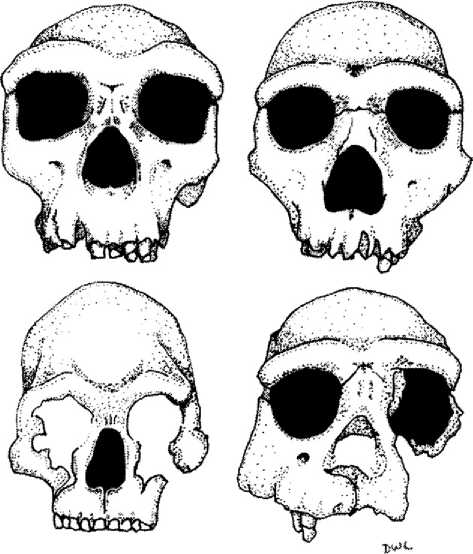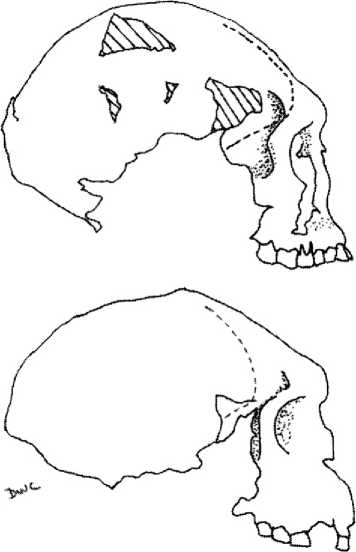Peter Brown and others have argued that there is no difference between the suggested ‘gracile’ and ‘robust’ fossil specimens and thus only one population is present. A single origin for the first Australians is likely if one takes into account (1) temporal considerations, (2) sexual dimorphism, that is, difference between the sexes in overall size and anatomical robusticity, and (3) cultural practices, for example, intentional cranial deformation (see below). While the multiregionalists suggest that the ‘graciles’ came first, followed by a ‘robust’ population, it could also be that there was gradual change within a single population toward greater robusticity. A recent study by Antion and Weinstein was the first to draw attention to this trend in overall increased robusticity during the later Pleistocene fossil hominin record.
Sexual dimorphism also needs to be considered. For example, Colin Pardoe and Colin Groves independently examined the sex allocations of the specimens and concluded that, if the multiregionalists were right about sex, their males were represented by ‘robust’ while most of their females were represented by ‘gracile’ specimens. In other words, the criteria one uses to determine sex are the same as those to determine which of the two ‘types’ one is examining.
Another important factor that Brown identified was the cultural practice of artificial cranial deformation, which appears to account for much of the ‘distinct’ morphology of the ‘robusts’ especially those from Kow Swamp. Cranial deformation is a result of parents deliberately or unintentionally altering their children’s head shape in infancy; it is said to look more attractive, or it is culturally distinctive, or it may simply result from swaddling or other cradling practices. It has been very widespread throughout the world over time: the Maya, the Aztec, some Plains Indians, some Hawaiians, the people of Espiritu Santo in Vanuatu, offshore islanders in Papua New Guinea, Lebanese Maronites and other Middle Easterners, and some women in the Toulouse region of France, all had artificially deformed crania.
Brown analyzed crania from Arawe, in the island of Melanesia, that are known to have been deliberately deformed, and compared them to crania from the Sepik River Region, known not to be affected by cranial deformation. He demonstrated that many of the ‘unique’ features observed in the Australian ‘robust’ crania are also present in the Arawe deformed specimens, that is, their ‘distinct’ morphology is likely the result of these populations practicing cranial deformation and certainly has nothing to do with a proposed link between them and the earlier H. erectus populations of Indonesia.
Also, while the Kow Swamp crania do show significant cranial thickness, Brown demonstrated that the thickness of the cranium observed in the female LM 1 is within the range observed in the Holocene female Murray Valley sample, while the male LM 3 specimen falls within the range of not only the male Murray Valley collection, but also the male Kow Swamp sample. Thus, again, cranial thickness between the ‘robust’ and the ‘gracile’ samples is not very distinctive at all.
The upper face of the ‘robust’ Late Pleistocene/ Early Holocene Australians and the Indonesian Middle Pleistocene H. erectus has most frequently been used by the multiregionalists as a unique ‘complex’ uniting these two demes to the exclusion of all others. This is particularly true of the long, flat frontal and developed supra-orbital torus. The supraorbital region of the Kow Swamp individuals is superficially similar to those observed in the Sangiran
H. erectus specimens with developed and continuous brow ridges. They are, however, even more similar to Middle Pleistocene African H. heidelbergensis fossils such as Kabwe (Zambia) and European ones such as Petralona (Greece), relative to H. erectus. Indeed they are well within the range of early and modern H. sapiens, that is, it is not a unique feature shared with H. erectus and the Australian Kow Swamp population (Figure 3).
Finally, there is no morphological evidence to support a Chinese origin for the Pleistocene Australians (e. g., Mungo and Keilor specimens), or Indonesians (e. g., Wajak cranium). Indeed, the only truly ‘gracile’ Australian specimen is LM1. A single specimen falling outside the general range is certainly noteworthy, but must be inconclusive. More significantly, however, LM1 could be a juvenile. When cremated, her skull came apart at the sutures, but matrix still covered the crucial basicranial region, which would tell us whether She was mature or not.
The development of the supra-orbital torus in most nonhuman primates, including early hominins, is associated with a process known as neuro-orbital disjunction (Figure 4). This is defined by the face being pushed out from the braincase, as in H. erectus; the braincase, including the anterior cranial fossae (which houses the frontal lobes of the brain), is positioned behind the face, so that the frontal lobes are long and relatively low. In other words, the robust supra-orbital of H. erectus is the result of the frontal (forehead) requiring a strong bridge of bone to haft the braincase to the upper face. Thus, the supra-orbital torus is a structural ‘supporting beam’ connecting the large and posteriorly oriented braincase to the face.
The condition in H. sapiens over the last 170 000 years or so, however, is for the complete opposite condition, that is, the anterior cranial fossae (which houses the frontal lobes of the brain) are located directly above the orbits (eye sockets), as opposed to the more posterior position of H. erectus. This results in a vertically oriented frontal bone, with the face positioned directly beneath, reducing the need for a structural ‘supporting beam’ (supra-orbital (brow-ridge)) linking the face to the cranium. This can be referred to as neuro-orbital ‘convergence’, that is, the face is high and vertically flat. This is clearly the condition in Kow Swamp individuals, even taking into account those individuals whose frontals have been affected by intentional cranial deformation; indeed, individuals that are not influenced much by intentional deformation show that the anterior

Figure 3 Comparison of Australian material with other non-erectus hominins. (Top left) H. heidelbergensis specimen from Petralonaq, Greece. (Top right) H. heidelbergensis specimen from Kabwe, Africa. (Bottom left) Modern human from Kow Swamp, Australia. (Bottom right) Homo erectus specimen Sangiran 17 from Indonesia.

Figure 4 Neuro-orbital disjunction/convergence. (Top) A modern human from Kow Swamp (KS1) showing the modern human condition of neuro-orbital convergence, as opposed to (bottom) the more archaic condition of neuro-orbital disjunction observed in the early H. erectus Sangiran 17 specimen.
Cranial fossae are located directly above the orbits in the typical modern H. sapiens fashion, and not posterior to them as in H. erectus (Figure 5). Therefore, the suggested ‘similarity’ between H. erectus and the Kow Swamp H. sapiens is the result of two very different processes, one biological (neuro-obital disjunction in H. erectus) and the other cultural (cranial deformation in some demes of H. sapiens). The phylogenetic analysis of Cameron and Groves of these homi-nins also clearly shows that both the Australian ‘gracile’ (Lake Mungo) and ‘robust’ (Kow Swamp) populations cluster together and with modern H. sapiens and not H. erectus, even taking into account cranial deformation of the Kow swamp population. Phylogenetic systematics was first established by Willie Hennig to help determine relationships and classify organisms that are based on evolutionary affinities as a result of identifying shared unique features. It is also often referred to as cladistics. Unique features shared Between species are used to help establish a common ancestry.
Phylogenetics is based on the allocation of taxa to groups based on the recognition that they share unique characters (synapomorphies) that distinguish them from their ancestors as well as more distantly related groups. The identification of these derived characters is based on the study of an outgroup. An outgroup is a group of closely related taxa, which are not directly part of the study group. If we were studying hominids, for example, the obvious outgroup would be the early Miocene hominoids and the Old World monkeys.
Synapomorphies establish sister-group relationships between taxa, while primitive features that are shared by at least two outgroups are assumed to be symplesiomorphies and cannot be used to allocate species to a clade. For example, when examining the New World and Old World monkeys an obvious symplesiomorphic feature is the presence of a tail, but when the great apes are included in such a study, the absence of a tail is a synapomorphy linking all primates without tails as hominoids. When looking at a finer resolution of detail, let us say groups within the hominoids, the absence of a tail is now of no phylogenetic significance as all hominoids are defined by not having a tail. The absence of a tail in homi-noids is meaningless in trying to determine which species are closely related. In this case the absence of a tail becomes a primitive, or plesiomorphic, feature of the hominoids. A synapomorphy of the hominins, however, might be an increase in brain size (relative to body weight). The parsimony analyses were generated using the computer program PAUP* version
Large supra-orbitals are known to occur in a number of recent H. sapiens too, especially in large robust males with narrow skulls, including some northern Europeans and African Bushmen, and in a number of fossil H. sapiens from Africa (Dar es-Soltan), Western Asia (Skhul V, Qafzeh), Europe (Madlec, Predmosti, Cro-Magnon), and East Asia (Zhoukoudian Upper Cave specimen 101). The robust supra-orbital is a primitive human feature, and not evidence of regional continuity. Its development in H. sapiens is a result of differential brain development and growth patterns, and as such, is distinct from the condition observed in H. erectus and other earlier hominins.
The remaining features that multiregionalists use to support a regional continuum between the Middle Pleistocene Indonesian H. erectus and the Late Pleistocene Australasians are largely functional in origin. These features include a large robust mandible (lower jaw), and large post-canine teeth (premolars and molars), which are clearly associated with the development of the masticatory apparatus (upper and lower jaws) and responses to diet. They are closely integrated as a functional complex and should not be isolated as individual features. As Wolpoff himself has shown, a large dental complex is observed in the sub-Saharan Africans, second only to Australians. These and other modern human groups were in most cases dependent on the mastication of largely unprepared food resources (little preparation before consumption), the molars pulping and grinding tough food items. In order to house a large dental complex, one requires a large robust mandible with its associated musculature. Clearly a small mandibular frame housing a large dental complex will result in masticatory stresses resulting in disastrous stresses and a breakdown of the masticatory system. As such, selective pressures would result in an increase in mandibular robusticity and increased post-canine tooth size to help cope with a tough and gritty diet; not to do so would result in a biomechanical failure of the masticatory apparatus and thus early death.




 World History
World History









